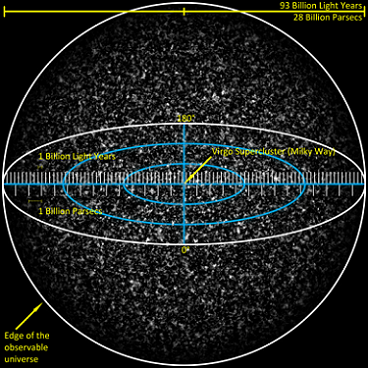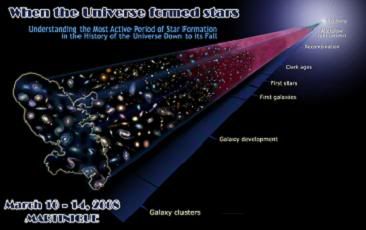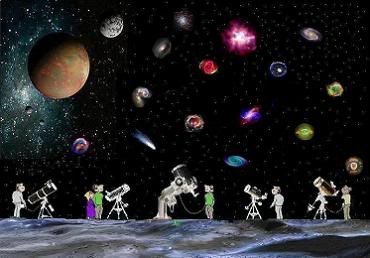Post by glactus on Sept 19, 2011 3:13:57 GMT

The observable Universe
This image is the visualization of the 93 billion light year � or 28 billion parsec � three-dimensional observable universe. The scale is such that the fine grains of light represent collections of large numbers of superclusters. The Virgo Supercluster � home of Milky Way � is marked at the center, but is too small to be seen in the image.

When the Universe formed stars
In Big Bang cosmology, the observable universe consists of the galaxies and other matter that we can in principle observe from Earth in the present day, because light (or other signals) from those objects has had time to reach us since the beginning of the cosmological expansion. Assuming the universe is isotropic, the distance to the edge of the observable universe is roughly the same in every direction�that is, the observable universe is a spherical volume (a ball) centered on the observer, regardless of the shape of the universe as a whole. Every location in the universe has its own observable universe which may or may not overlap with the one centered on the Earth.

The Astronomy club looking at the Universe
In practice, we can see light only from as far back as the time of photon decoupling in the recombination epoch, which is when particles were first able to emit photons that were not quickly re-absorbed by other particles, before which the Universe was filled with a plasma opaque to photons.
The current comoving distance to the particles which emitted the CMBR, representing the radius of the visible universe, is calculated to be about 14.0 billion parsecs (about 45.7 billion light years), while the current comoving distance to the edge of the observable universe is calculated to be 14.3 billion parsecs (about 46.6 billion light years), about 2% larger.
The age of the universe is about 13.75 billion years, but due to the expansion of space we are observing objects that were originally much closer but are now considerably farther away than a static 13.75 billion light-years distance. The diameter of the observable universe is estimated to be about 28 billion parsecs (93 billion light-years), putting the edge of the observable universe at about 46 - 47 billion light-years away.
Credits: These are non copywrite images.
Text by Wikipedia
Space Art by Glactus


